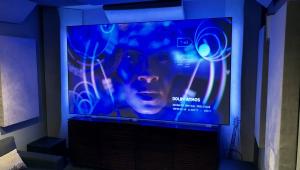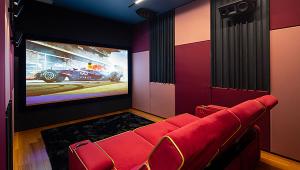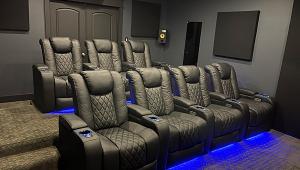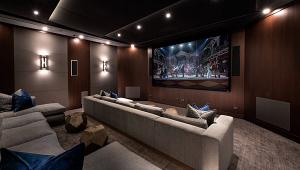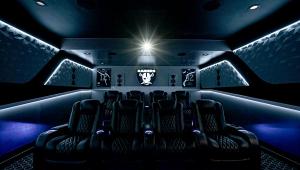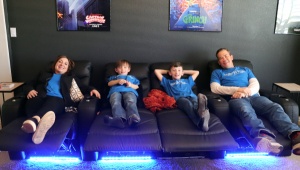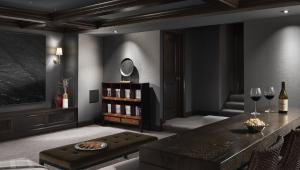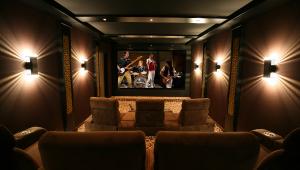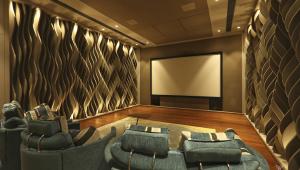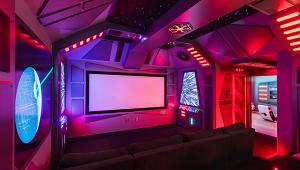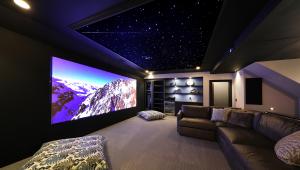Demonstrating Your Home Theater System, Part II
Pulling off a killer demo is definitely fun, but it's also a lot of work. You now have to wear the hats of producer, director, and, of course, editor. Before selecting a demo for a show, we, in the industry, review countless movies and scenes to find something that fits all of the criteria for a great demo listed below.

Demonstration Length
With a couple of exceptions, the demonstration should generally be no longer than six or seven minutes. A demo that lasts too long might lose the viewers' attention, especially if they have seen the material before in its full length.
Everyone Loves a Story
If the demo is from a movie, it should be a micro-story; it needs to have a beginning, middle, and end. A complete scene allows the viewer to experience a sense of fulfillment. By contrast, nothing is as frustrating as cutting off a scene in the middle. Imagine a very intense chase and, before it reaches its climax, you turn it off. Don't cheat your audience out of knowing how everything resolves itself.
Believe it or not, conforming to these two rules is really challenging. We often find a great scene that just goes on far too long.
Uplifting Is Always Better Than a Downer
This is one of the toughest rules to conform to. Action scenes often involve someone getting hurt, or worse. While scenes of explosions appeal to male viewers, they could turn off some of the women or smaller children. Destroying a Klingon spaceship in Star Trek might not upset anyone, but the death and carnage of Blackhawk Down is not exactly a great "friends and family" demo.

Tribeman and his captive audience.
Sensory Stimulation Is What It's All About
If you've been to a good theme park, you probably noticed that the rides are getting more and more interesting. With amazing stereo sound, 3-D high-definition projection, and motion vibration for your seats, the parks are trying to capture your imagination and emotions with a calculated stimulation of all of your senses. I'll never forget the final explosion at Universal Studios' Terminator 3-D exhibit. A frozen monster exploded in front of my eyes, and then, on cue, tiny ice crystals dropped on me from the ceiling. What an effect! Everyone in the audience cheered. OK, you aren't Universal, but you can still stimulate the senses in your demo. A good home theater demonstration should stimulate four senses.
Visual Stimulation
The program material should be colorful and sharp. If you don't have great imagery, it will distract from the theater-like environment you are trying to create.
Aural Stimulation
There should be a wonderful sense of acoustic space, meaning good separation, good surround, and, if possible, a great musical score. This one point will make the difference between your viewer feeling like he or she is at the movies as opposed to watching TV.
Physical Stimulation
In the mid 1970s, Universal Studios released a movie called Earthquake. It was presented in "sensurround," a technique of placing very large (you could actually walk inside of them) horn-loaded woofers around the theater to enhance the action in the movie. While the story itself was not very good, the audience vicariously experienced what an earthquake might feel like. Unfortunately, the effect was a little too realistic. In several older theaters, plaster fell off their ceilings into the audience. (Maybe this is where the idea for the ice crystals came from.)

I'm not suggesting that you attempt the same in your home theater. However, reproduction of deep bass in a soundtrack adds a physical component to what's happening on the screen. When set up properly, you feel what is happening, and it has a direct bearing on your reaction to the scene. More than anything else, appropriate bass reproduction and the right program material can give your viewers goose bumps.
 For those of you not fortunate enough to have seen the original Star Wars in a good theater, the opening scene produced one of those rare moments when the audience was totally drawn in by the visual, aural, and physical experience. The Empire's battle cruiser, slowly traveling from behind you and over your head, became a defining moment for good bass reproduction. (As a side note, a group of us went to see Star Wars in Chicago, during CES. We were sitting with Tom Holman, before he went on to establish some of the earlier criteria at THX. We always wondered what effect that scene had on his decision to join Lucasfilm.)
For those of you not fortunate enough to have seen the original Star Wars in a good theater, the opening scene produced one of those rare moments when the audience was totally drawn in by the visual, aural, and physical experience. The Empire's battle cruiser, slowly traveling from behind you and over your head, became a defining moment for good bass reproduction. (As a side note, a group of us went to see Star Wars in Chicago, during CES. We were sitting with Tom Holman, before he went on to establish some of the earlier criteria at THX. We always wondered what effect that scene had on his decision to join Lucasfilm.)
And Finally, Imagination Stimulation
If you've chosen appropriate program material, it should draw the viewer into the story or action. Your audience should "be there." They should forget that this is only a demonstration. At this point, the viewer has absorbed the experience in every way.
 Perhaps one of the greatest demos of all is chapter 22 in Seabiscuit, the showdown with War Admiral. This sequence has it all—a great picture and musical score with good bass, a beginning, a middle, and an uplifting finale. When I saw this movie in the theater, I noticed that the audience was screaming and cheering Seabiscuit on to victory. For a brief moment, they felt they were actually at the race and could effect the outcome. I knew this was something very special, and I couldn't wait until the DVD release.
Perhaps one of the greatest demos of all is chapter 22 in Seabiscuit, the showdown with War Admiral. This sequence has it all—a great picture and musical score with good bass, a beginning, a middle, and an uplifting finale. When I saw this movie in the theater, I noticed that the audience was screaming and cheering Seabiscuit on to victory. For a brief moment, they felt they were actually at the race and could effect the outcome. I knew this was something very special, and I couldn't wait until the DVD release.
So, what demos have worked? Well, besides Seabiscuit, here are a few to help you get started:
Vertical Limit
The chapter titled "Use Your Axe." Two members of a climbing team are left dangling on a mountain. This scene is excruciatingly tense and exciting. It looks and sounds great, but it's a little bit long and should be cut off after the female climber comments: "You're sick."
 The Core
The Core
A pretty mediocre movie about a trip to the earth's center to stop earthquakes and the general destruction of mankind. Use chapter 3, which begins with the space shuttle preparing to land. This is a great scene because it begins and ends perfectly with chapter breaks. We have used it successfully at several shows and will continue to, especially if it is released in high definition.
 Red Planet
Red Planet
Another mediocre space opera. However, the chapter entitled "Bye Bye Sweetie" presents a stunning use of surround as small, flying killer-robots slowly circle the room. The surround is so good, you'll find yourself looking up at the speakers. Knowing when to stop is tricky because the ending jumps quickly to another scene.
 Independence Day
Independence Day
From the beginning of the movie right to the scene where the generals decide that there is "something" out there.
I realize that this list is short. Nevertheless, half the fun is searching for the right material for you and seeing how it tracks our "rules."
In the end, a properly set-up home theater can take you to another place, where you gasp, laugh, cry, or just have a great time. The demo only validates the fact that you got it right.

Most importantly, have fun. . .. And don't forget to call that neighbor.
- Log in or register to post comments
